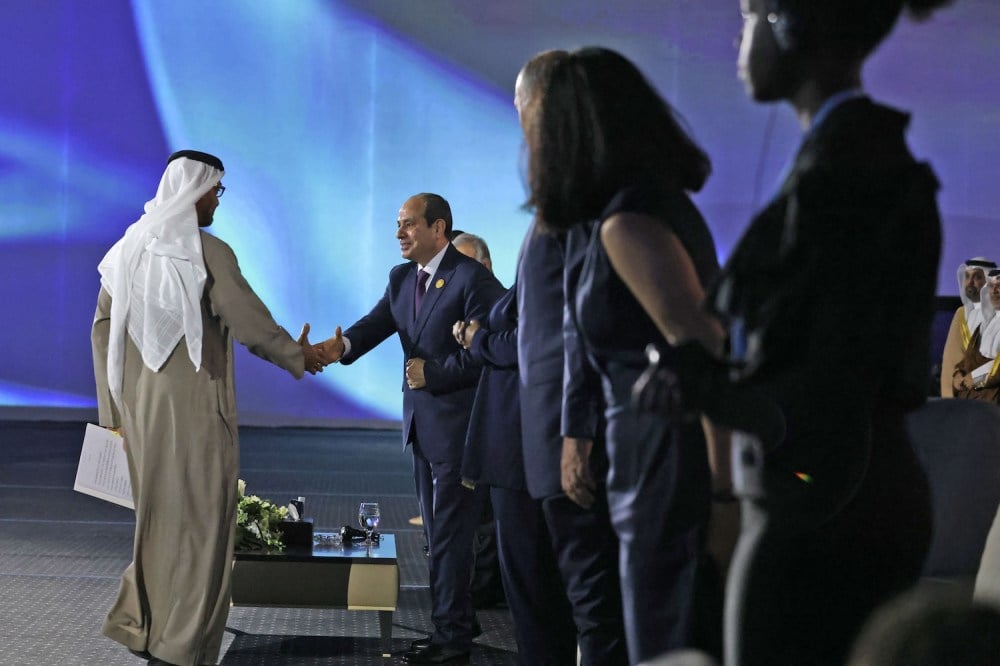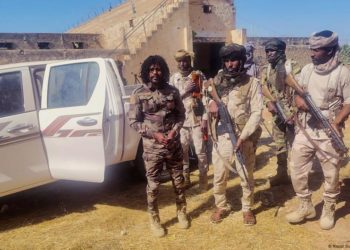U.S. President Donald Trump’s dramatic decision to bomb Iranian nuclear sites last weekend invited many a warning that the United States shouldn’t stumble into Iran as it did with Iraq in 2003. But during his trip to the Middle East in May, Trump had already shown an intent to signal to the region a new future.
If Washington’s relations have for so long been defined around oil and security in the Middle East, Trump’s visit this time featured data, artificial intelligence, and digital infrastructure. His dramatic lifting of sanctions on Syria and normalization of ties with the new administration in Damascus captured the headlines. But he returned home with much more than symbolic handshakes. He had signed a portfolio of tech-driven agreements, signaling where Gulf powerhouses are attempting to steer their countries and the wider region.
The stark contrast Trump drew in his historic Riyadh speech on May 13, between the Gulf’s surging economies and Iran’s crumbling economy, struck a chord—especially in Iran, where figures across the political spectrum used it to advocate normalization of ties with the United States and pursuit of Saudi-style economic development. Now, as Iran is reeling from the effects of a brutal war with Israel and the United States, having lost top officials, hundreds of civilians, and much infrastructure, the contrast is even clearer.
But the Middle East had been going through a grand transformation long before Trump’s trip. For many years now, the region has witnessed gradual but fundamental changes with a clear trajectory. Core to this process is the decline of transnational militias and revolutionary ideologies as central to Middle Eastern politics. By directly confronting Iran’s Revolutionary Guards, Israel also aimed to put a definitive end to the past half century of a regional landscape dominated by nonstate actors.
In their place, strong sovereign states and demands for economic development and public services are taking center stage. The process was well underway before Oct. 7, 2023, but the consequences of Hamas’s murderous attack on that day, and the Israeli war that ensued, have only sped it up. Iran’s so-called Axis of Resistance, the most formidable and cohesive coalition of nonstate actors in the region, now lies in ruins, and regional states have come to prioritize state-to-state ties, less keen on sponsoring militias in one another’s countries.
The era of ascendancy for ideological nonstate actors arguably began in 1967 with Israel’s victory over Egypt, Syria, and other Arab countries in the Six-Day War. Following the humiliating defeat of the Arab armies, the PLO transformed from an Egyptian-backed outfit to a transnational guerrilla organization, leading a popular cause of national liberation. The 1969 Cairo Agreement proved a pivotal turning point in the history of Middle Eastern geopolitics. Signed by Yasser Arafat and Emile Bustani (on behalf of the Lebanese government), and under the auspices of Egyptian President Gamal Abdel Nasser, the agreement aimed to formalize the status and activities of Palestinian armed groups in Lebanon.
In retrospect, the agreement has become widely seen as a landmark moment in the rise of nonstate actors in Middle Eastern politics, especially in the context of pan-Arab and anti-Israel mobilization. It set multiple precedents, including the normalization of nonstate armed groups, erosion of states’ sovereignty, and normalization of parallel governance, which all proved to be an inspiration for other actors.
Meanwhile, the PLO and other Arab revolutionary militias wasted no time in meddling in the internal affairs of Arab countries such as Jordan, Kuwait, Lebanon, and Iraq. But this fit very well with the mood of the times, as most important forces in Arab politics defined themselves transnationally and the Palestinian cause transcended all else. The Muslim Brotherhood had done so since its founding in 1928, pre-dating most Arab states by decades. The pan-Arab Baath Party had come to power in Iraq and Syria in the 1960s, and the Baathist regimes there supported nonstate actors in various Arab countries.
The same was true of Muammar al-Qaddafi’s Libyan regime, which seized power in 1969 and helped destabilize regional politics. Following the 1979 Iranian revolution, Tehran’s sponsoring of various militias in countries such as Iraq, Lebanon, and Yemen and in the Palestinian territories further fragmented Arab political life and undermined the sovereignty of Arab countries.
The result has been catastrophic: Many Arab countries have been effectively turned into failed states, without sovereign power over their lands. Civil wars, always with foreign meddling and sometimes with outright foreign occupation, have bedeviled political life in Iraq, Lebanon, Libya, the Palestinian territories, Syria, Sudan, and Yemen. On the other side of the equation, states such as Baathist Iraq and Khomeinist Iran wasted their potential and risked their future by spending their resources not on their own development but on extending their influence in other countries, in the process destabilizing them and the whole region.
The Arab Spring, which ostensibly began with democratic hopes, only accelerated this process. By toppling long-standing autocrats in Egypt, Libya, Tunisia, and Yemen, it exposed these countries’ domestic politics to intervention and competition from regional powers. The result has been a series of civil wars—often with sectarian dimensions—in which regional heavyweights such as Iran, Saudi Arabia, Turkey, and the United Arab Emirates intervened to shape outcomes. This power vacuum further fueled the rise of nonstate actors, most notably the Islamic State, whose 2015 assault along the Iraqi-Syrian border symbolized the collapse of state authority across much of the region.
The period from 2011 onward profoundly altered regional dynamics, resulting in the weakening or collapse of the traditional political centers in the Arab world: Egypt, Iraq, Libya, and Syria. This diminished the traditional urban, intellectual, and cultural centers of Arab nationalism and political activism—Baghdad, Beirut, Cairo, Damascus—and left a leadership vacuum in the Arab world. With the collapse of ideologically driven or nationalist models, the Gulf states’ influence was further elevated, which helped project their development models as the new regional standard.
Under Crown Prince Mohammad bin Salman, the de facto Saudi leader since 2017, Riyadh has moved away from its sponsorship of transnational Islamism, instead prioritizing stability and economic growth for itself. Since 2019, a series of diplomatic deals have ended the most durable rifts in the region. The Saudis have upgraded ties with Iran, Turkey, and Qatar. Turkey and the UAE have ended their pernicious enmity, which played out over the domestic politics of Egypt, Libya, and Syria. The Abraham Accords normalized ties between Israel and the UAE, Bahrain, Morocco, and Sudan. Most consequentially, the downfall of Iran’s Axis of Resistance promises an end to the last of the major nonstate actors and transnational ideological frameworks.
Elsewhere, the Kurdistan Workers’ Party (PKK), a significant transnational force active in Iraq, Iran, Syria, and Turkey, has laid down its arms and promised to engage in the political process. Long before the recent move, it had abandoned separatism as a goal.
Ahmed al-Sharaa’s new government in Syria is exemplary of this new approach, bringing the final blow to the Axis of Resistance. Damascus’s new rulers have made clear that they seek to focus on Syria and its economic development. They want to solidify the fruits of their revolution, not export it. Sharaa’s first major pilgrimage was to Riyadh, not Mecca, a rite of passage to statesmanship for the former militia leader.
Palestinians want a state of their own, not the destruction of other states in the region, a conviction further solidified following the catastrophic outcome of Hamas’s Oct. 7 attack. The political fortunes of Hamas are at their nadir. Its fellow ideological allies in the Muslim Brotherhood have faced political defeats and crackdowns in Jordan, Kuwait, and Morocco.
New approaches have been adopted in Baghdad and Beirut, once hubs of the Axis of Resistance. Following Hezbollah’s battering by Israel, Lebanon’s new government eschews the Iran-backed militia and, albeit slowly, is moving to assert its sovereignty. Even in Iraq, the leadership is moving toward asserting state sovereignty vis-à-vis powerful Iran-backed militias. Baghdad now, at least, aims to balance between its relations with major Arab capitals and Tehran. The coming parliamentary elections this year will likely solidify this orientation.
In Tehran itself, too, change is happening. Ayatollah Ali Khamenei, Iran’s 86-year-old supreme leader, is a lifelong revolutionary who has staked his life on the spread of the Islamist revolution. But he is likely to be the last such leader for Iran. For years, he had chanted “Death to Israel” and “Death to America” while selling security and defiance domestically in a region that often saw major upheaval. But at the moment of truth, when Iran found itself at war with these countries, he hid in his bunker and was nowhere to be seen. When he finally came out to give a speech, he looked frail and a shadow of his former self.
But while Khamenei’s ability to dictate Iran’s future has taken a major blow, he is now left with the difficult option of overseeing a transition that would hope to ensure the continuity of his regime.
In Iran’s presidential election last year, the reformist Masoud Pezeshkian ran on a platform of engagement with the world and roundly defeated the hard-liner ideologue Saeed Jalili. The same result has held in every single presidential election since 2013 (except in 2021, when no serious pro-reform candidate was allowed a run). Significant sections of Tehran’s ruling establishment now believe that the country must move away from its disastrous policy of backing the Axis of Resistance toward prioritizing its own economic development. This explains the enthusiastic hopes that many Iranians had placed in the talks with the United States and in their new ties with the Saudis. When an extremist Iranian cleric recently insulted the Saudi royal family on a trip to Mecca, he was roundly condemned by Iranian officials.
Many obstacles remain. Israel’s brutal war on Gaza and its continued occupation of the Palestinian territories deprive Palestinians of self-determination and unduly delay Israel’s own integration in the region. Civil wars still bedevil Libya, Sudan, and Yemen. But the trajectory of regional politics is clear. These days, many regional leaders seem to carry the ethos of former Chinese leader Deng Xiaoping, who, after touring southern China in 1992, famously quipped: “I don’t care if the cat is black or white, so long as it catches mice.” He wished to put an end to decades of ceaseless ideological conflict over the style of China’s economy, instead asserting that “development is of overriding importance.”
In the Middle East, too, an unmistakable Dengist spirit is now in the air, with a focus on effective state institutions, quality public services, stable state-to-state relations, and economic flourishing. This is the prerequisite for any dreams of a more just and democratic Middle East. For too long, the Middle East has been a byword for internecine conflict and endless wars. But as the guns fall silent, the region has a chance to chart a path toward a different future.
The post The Middle East’s End of Ideology appeared first on Foreign Policy.




